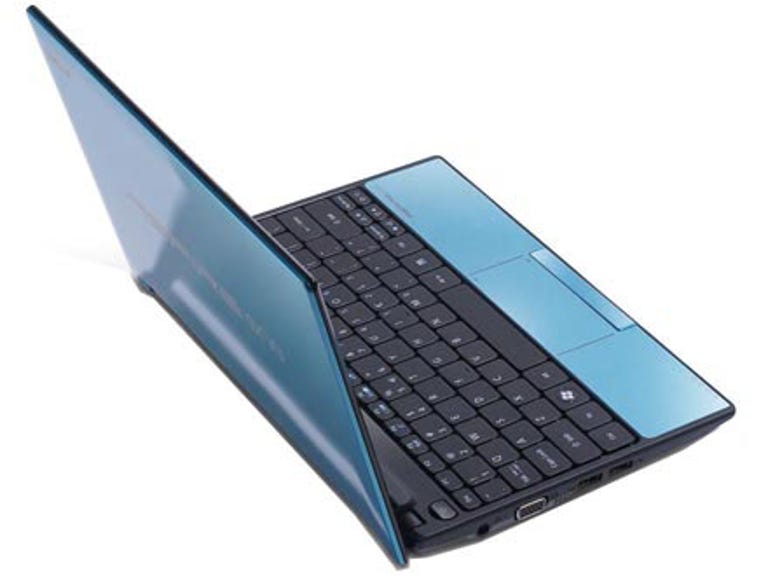 Why You Can Trust CNET
Why You Can Trust CNET Acer Aspire One D255 review: Acer Aspire One D255
There are better looking netbooks around, but thanks to its low price, dual-core processor, excellent screen and keyboard, the Acer Aspire One D255 offers great value for money.
The Acer Aspire One 255 tries to stand out from the netbook crowd by packing in a dual-core Atom processor and coming preloaded with both the Windows 7 Starter and Android 2.1 operating system. Priced at £280, is it worth your hard-earned dosh?
The Good
The Bad
The Bottom Line
Aspire higher
Externally, the D255 looks little different to other recent models in the Aspire One range. Like most netbooks on the market, it has a glossy lid with a matte finish around the keyboard. In the UK, it'll be available in four colours (black, red, white and brown). Although the finish is a little plasticky, the netbook actually feels quite solid when you pick it up. With the lid shut, it's quite thin at 24mm. It's light, too, weighing just 1.25kg. In saying that, the overall look and feel isn't as impressive as something like the Samsung N220.
The D255 doesn't break from the norm when it comes to the range ports on offer. You get three USB ports, along with a VGA connector for hooking it up to an external monitor. Naturally, there's Ethernet and Wi-Fi along with an SD card reader for transferring files from portable devices like cameras and smart phones. That's the lot, though. You miss out on extras like an HDMI port and Bluetooth support, which you'll find on higher end machines. Nevertheless, the 250GB hard drive is relatively large for a netbook in this price range.
Practicality plus
Similar to many of Acer's recent laptops, the D255 has an isolated keyboard design, where keys seem to float above the surface of the laptop rather than looking as if they were stamped out of the chassis. The keys are relatively large and there's a decent amount of space between them, so it's easy to get up to a decent typing speed.

The D255's isolated keyboard has keys that seem to float above the surface of the chassis.
The 10.1-inch screen is obviously quite small, but it has a decent resolution of 1,024x600 pixels. It uses LED backlighting, so it's very bright, and its glossy coating helps colours to really stand out. The display's viewing angles are wide, too, which may come in useful if you want to share a movie with a friend while travelling. That said, the glossy coating is a little reflective, especially if you're using it under bright overhead lights.
Two for the price of one
The D255 is the cheapest model we've seen yet to use Intel's new dual-core N550 processor, which is clocked at 1.5GHz. This is helped along by the standard 1GB of memory you'll find on pretty much every netbook. Unfortunately, the D255 refused to complete the PCMark05 benchmark test, but as on the Samsung NF210, the processor did bring a noticeable improvement in the overall responsiveness of the netbook. It still doesn't offer enough grunt for tasks like smooth playback of high-definition video from the BBC's iPlayer service, however.
Netbooks always offer pretty dire levels of 3D performance and, despite the help from the dual-core Atom chip, this model's integrated graphics solution was no different in this regard. In 3DMark06, it racked up a score of just 151, so you'll only be able to play very old 3D games at a decent frame rate.
When it comes to battery life, the D255 is a fairly average performer, at least by netbook standards. In our intensive Battery Eater test, it managed to keep puffing away for four hours and 12 minutes before it was crying out for a recharge. The Samsung N130, in comparison, ran for just under ten hours.
Put the dual-boot in
Of course, the other feature that sets the D255 apart from the competition is the inclusion of the Android operating system, alongside Windows 7. This does boot much faster than Windows 7, but apart from this, it's difficult to see why you would make much use of it. There are simply too many problems with the implementation of it on this netbook. When you open most of the Android applications, for example, the only way to exit them is to hit the 'Esc' key -- you can't close them using the cursor or trackpad buttons.
Furthermore, many applications seem to run slower on Android than they do on Windows. Playback of standard-definition video on the BBC's iPlayer ran smoothly on Windows, but was very jerky on Android. The Android app store isn't included, either, so there's no easy way to install new applications. Thankfully, you don't have to use Android at all. You can easily configure the D255 not to offer Android as an option at boot time, via a simple Windows application.
Conclusion
The Acer Aspire One D255 may not be the best looking netbook around, and the addition of the Android operating system isn't as useful as you might think. On a more positive note, however, the dual-core processor does bring a welcome boost in performance, and costs little more than most single-core rivals -- as such, it's easy to recommend.
Edited by Emma Bayly


